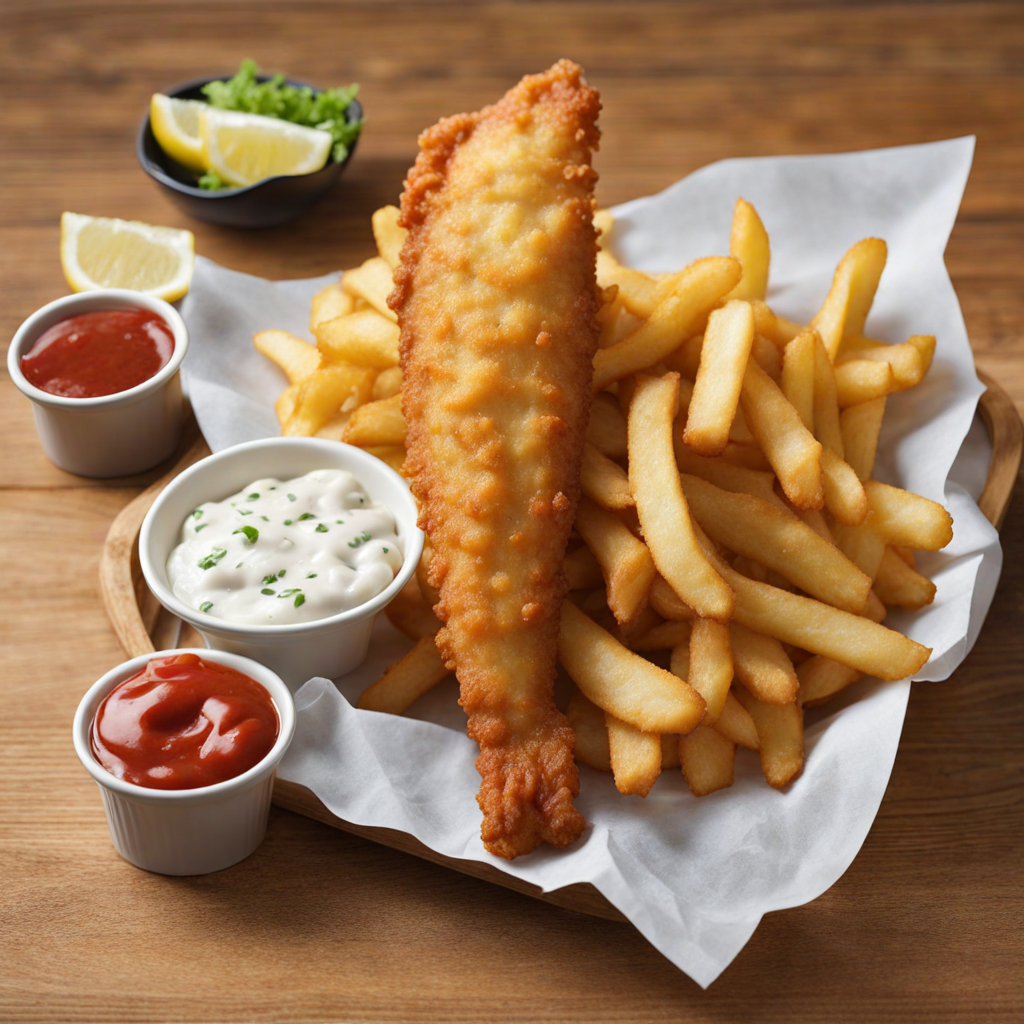Fish and Chips
Fish and Chips is a quintessential New Zealand dish that encapsulates the country's love for fresh seafood and hearty meals. This iconic meal typically features a generous portion of battered and deep-fried fish, often sourced from the pristine waters surrounding New Zealand. The most commonly used fish varieties include snapper and hoki, which are celebrated for their flaky texture and mild flavor. The fish is coated in a light, crispy batter that creates a delightful contrast to the tender fish inside, making each bite a perfect combination of crunch and softness. Accompanying the fish is the 'chips' component, which refers to thick-cut fries that are golden, crisp, and fluffy on the inside. These chips are often seasoned simply with salt, allowing their natural potato flavor to shine. In New Zealand, it’s also common to find variations that include kumara chips, made from sweet potatoes, adding a unique sweetness and a vibrant color to the dish. The pairing of the crispy fish with the hot, satisfying chips is a comforting and filling experience that evokes a sense of home and tradition. To enhance the flavor experience, Fish and Chips are usually served with a side of tangy tartar sauce, which complements the fish beautifully. Additionally, a squeeze of lemon juice adds a refreshing brightness that balances the richness of the batter. Some people enjoy their meal with a side of mushy peas or a sprinkle of vinegar for an extra zing. This dish is often enjoyed by the seaside, where you can savor the taste of the ocean, making it not just a meal, but a delightful culinary experience that captures the essence of New Zealand's vibrant food culture.
How It Became This Dish
The History of Fish and Chips in New Zealand #### Origins of Fish and Chips Fish and chips, a beloved dish that has become synonymous with fast food in many parts of the world, traces its roots to the UK, specifically to the working-class communities of the industrial north of England. The combination of fried fish and chips (deep-fried potato slices) emerged in the 19th century, propelled by the availability of fish from the North Sea and the introduction of the potato from South America. The dish quickly gained popularity due to its affordability and satisfying nature, making it an ideal meal for laborers. The origins of fish and chips are often attributed to Jewish immigrants in the UK, who are believed to have introduced fried fish to the British palate, while the concept of fried potatoes was already common. The first fish and chip shop, known as "chippy," opened in London in 1860. This new fast-food option became an essential part of British culture, particularly during World War I and II, when fish and chips were one of the few foods that remained available to civilians amid rationing. #### Arrival in New Zealand The introduction of fish and chips to New Zealand can be traced back to the late 19th century. As British settlers arrived in the land of the long white cloud, they brought their culinary traditions with them. By the 1900s, fish and chips shops began to appear in major cities like Auckland and Wellington. The combination of fresh seafood from New Zealand's abundant waters and the British technique of frying created a dish that resonated with the local populace. The growth of the fishing industry in New Zealand also played a pivotal role in the rise of fish and chips. With a coastline that stretches for over 15,000 kilometers, New Zealand is home to a diverse range of fish species, including snapper, hoki, and tarakihi, which became staples in local fish and chip shops. The accessibility of fresh fish allowed for the establishment of a thriving industry centered around this dish. #### Cultural Significance Fish and chips quickly became more than just a meal; they evolved into a cultural icon in New Zealand. The dish is often associated with family outings, picnics by the beach, and celebrations. It embodies a sense of community and togetherness, often enjoyed in casual settings. Many Kiwis have fond memories of visiting their local fish and chip shop, waiting in line with family or friends, and savoring the hot, crispy meal wrapped in paper. As New Zealand's multicultural landscape expanded, so did the variations of fish and chips. Immigrants from various cultures contributed their own culinary influences, leading to a diverse range of offerings in fish and chip shops. For instance, the introduction of Asian-inspired flavors, such as sweet chili or soy sauce, became popular among consumers looking for a twist on the traditional dish. #### Development Over Time The mid-20th century marked a period of significant growth for fish and chip shops in New Zealand. The post-World War II economic boom saw an increase in disposable income, leading to greater dining out habits. Fish and chips remained an affordable and accessible choice for families, solidifying its place in the New Zealand food landscape. The 1980s and 1990s brought about changes in dietary trends, with an increasing awareness of health and nutrition. This shift challenged traditional fish and chip shops to adapt. Many began offering healthier cooking methods, such as grilled fish instead of fried, as well as introducing a wider variety of sides, including salads and steamed vegetables. However, the classic battered and fried fish and chips remained a staple, with many shops preserving the traditional methods that had been passed down through generations. The advent of globalization and the internet in the late 20th century also influenced the fish and chip scene. New Zealanders began to travel more and experience international cuisines, leading to a growing appreciation for gourmet interpretations of traditional dishes. As a result, some fish and chip shops began to elevate their offerings, using locally sourced, sustainable fish and innovative cooking techniques to attract a new wave of customers. #### Contemporary Trends Today, fish and chips in New Zealand have embraced a new wave of culinary creativity while maintaining the traditional roots of the dish. Many fish and chip shops prioritize sustainability, sourcing fish from responsible fisheries and focusing on environmentally friendly practices. Local ingredients, such as organic potatoes and seasonal vegetables, are often highlighted, reflecting a growing trend toward farm-to-table dining. Food trucks and pop-up restaurants have also become increasingly popular, offering gourmet fish and chips with unique twists. From tempura-style batter to creative dipping sauces, these modern interpretations cater to an evolving palate while honoring the dish's original essence. The annual "Fish and Chip Day," celebrated on the last Friday of September, showcases the dish's cultural significance in New Zealand. Communities gather to enjoy fish and chips, often in fundraising events for local charities. This celebration not only highlights the enduring popularity of the dish but also emphasizes its place in the hearts of Kiwis as a cherished national food. #### Conclusion The journey of fish and chips in New Zealand is a testament to the country's rich culinary heritage and its ability to adapt and evolve. From its humble beginnings brought by British settlers to its status as a beloved national dish, fish and chips continue to hold a special place in the hearts and stomachs of New Zealanders. Whether enjoyed on a casual night out, at the beach, or during a community festival, fish and chips remain a symbol of connection, nostalgia, and the shared love of good food. As New Zealand continues to embrace culinary innovation, the future of fish and chips looks bright, promising new flavors and experiences while honoring its storied past.
You may like
Discover local flavors from New Zealand







